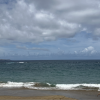
Being in a new country and culture is definitely a big change, and the last few weeks have been intense. Not necessarily in a bad way, but it’s been a lot. When I reflect on my experience since arriving in Granada, two words come to mind: adjusting and exploring.
The most obvious adjustment to being in a new country is all of the big and little differences that add up to what’s known as culture shock—everything from language to food to the unspoken expectations for interactions. To my pleasant surprise, I’ve found that my Spanish skills are quite good and I haven’t had too much trouble with the accent or the speed with which people talk, even though granadinos are famous for dropping the ends of words (so the city I’m in becomes Graná instead of Granada). Expressions and slang, on the other hand, have been challenging since I’ve never encountered most of them before, and people tend to combine expressions in a way that can make it hard to figure out the meaning from context. I’m doing a lot of guessing or interrupting a conversation to ask what an expression means. I’ve also been keeping a running list of expressions and slang that I’m learning, which I might share on this blog at some point!
The other linguistic challenge is regionally specific words. I’ve had a lot fewer instances of not knowing the Spanish word for something than of knowing a Spanish word for something but not the one that’s used in Spain. For instance, I recently asked my host mom if she had a curita—a band-aid—and was met with a blank stare until I showed her my papercut, whereupon she gladly gave me a tirita. A similar thing happened a few days ago when I asked a cafe worker for a straw with which to drink my smoothie and had to resort to pantomime in order to get one. But overall, I’ve been enjoying discovering the differences in how language is used, and I’m starting to get more comfortable with Spanish-isms.
Another area that’s been a huge adjustment is knowing what the expectations are for all the little interactions that I usually do on autopilot at home. For instance, in Spanish cafes you usually seat yourself (but not always), while in restaurants it depends and in some (but not all) bars it’s usually a fend-for-yourself case of finding a space to occupy and getting a server’s attention. Since I never really know what I’m supposed to do, I’ve resorted to hovering awkwardly until I either see what everyone else is doing or am told. Americans also really like making lines. At the pharmacy, the coffee shop, you name it, Americans will form a line to wait their turn. In Spain? Not so much. Usually you just figure out who’s last and go after them. While all of these little expectations are things I’m slowly figuring out, not quite knowing what the rules are means that many of my day-to-day tasks require more brain power than they would at home.
With adjusting to a new place comes exploring it. With orientation now firmly behind me, I’m settling into my class routine. While orientation was super helpful for getting a basic grasp of Granada, classes are making my life feel a bit more normal. The rhythm of my class schedule creates more consistent free time than I had during orientation, and I’m taking advantage of that free time to explore the city.
For me, exploring Granada has taken several forms. On a very basic geographic level, I’ve been trying to take different routes from the IES Abroad center back to my homestay to discover new places and improve my sense of direction; and on weekend mornings I’ve been going for somewhat aimless walks to discover new neighborhoods. The combination of these strategies has led me to some wonderful discoveries, including a number of excellent bookstores and a really delightful store that sells nothing but rubber ducks.
I’ve also been trying lots of different places for food, since I think that food is a great way to explore any place. Between having dinner somewhere for no reason other than that I walked by and it smelled good and asking locals for recommendations, I’ve discovered lots of tasty places to eat, many of which I probably wouldn’t have found on my own.
And on all my walking around the city, I’ve been allowing myself time to stop and admire the view! Granada has so much interesting architecture and so many gorgeous views, and pausing on my walk to class to take in the landscape or a particularly interesting building is helping me feel more connected to the place.

Carmen Miller
I’m a Comparative Literature major at Haverford College with an interest in how cultures and stories interact with each other. I love baking, writing, hiking, and exploring new places. And I can never resist the siren song of a good library!







